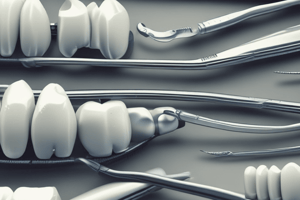Podcast
Questions and Answers
What is the primary focus of operative dentistry?
What is the primary focus of operative dentistry?
- To extract damaged teeth
- To diagnose and restore hard tooth structures (correct)
- To perform teeth whitening procedures
- To enhance the color of teeth
Which of the following is NOT a type of hard tooth structure?
Which of the following is NOT a type of hard tooth structure?
- Cementum
- Gum tissue (correct)
- Dentin
- Enamel
What is a characteristic of incipient caries?
What is a characteristic of incipient caries?
- It can successfully be reversed (correct)
- It is the same as acute caries
- It affects the dentin only
- It is irreversible
What type of caries progresses rapidly and is referred to as rampant caries?
What type of caries progresses rapidly and is referred to as rampant caries?
Attrition is primarily caused by what type of action?
Attrition is primarily caused by what type of action?
Which condition is characterized by defective enamel formation?
Which condition is characterized by defective enamel formation?
Which phase is not part of the operative dentistry process?
Which phase is not part of the operative dentistry process?
What factors contribute to dental caries?
What factors contribute to dental caries?
Flashcards
Operative Dentistry
Operative Dentistry
The branch of dentistry focused on restoring damaged tooth structure.
Hard Tooth Structures
Hard Tooth Structures
Hard tissues of the tooth, like enamel and dentin.
Incipient Caries
Incipient Caries
A type of tooth decay in its early stages. It can be reversed with proper care.
Acute Caries
Acute Caries
Signup and view all the flashcards
Attrition
Attrition
Signup and view all the flashcards
Amelogenesis Imperfecta
Amelogenesis Imperfecta
Signup and view all the flashcards
Factors Contributing to Dental Caries
Factors Contributing to Dental Caries
Signup and view all the flashcards
Operative Dentistry Process
Operative Dentistry Process
Signup and view all the flashcards
Study Notes
Operative Dentistry
- Branch of dentistry that focuses on diagnosing, eliminating, and preventing tooth structure defects
- Aims to restore tooth function and aesthetics
- Also known as Restorative Dentistry or Conservative Dentistry
Hard Tooth Structure
- Enamel
- Dentin
- Cementum
Defects Affecting Hard Tooth Structure
- Caries: Infectious disease dissolving and destroying calcified tooth structure
- Factors contributing to caries:
- Host: Tooth and saliva
- Microbiota in the area
- Diet
- Classification:
- Location:
- Primary/initial caries
- Secondary/recurrent caries
- Extent:
- Incipient caries (reversible)
- Cavitated caries (nonreversible)
- Rate:
- Acute (rampant) caries
- Chronic (slow, or arrested) caries
- Location:
- Factors contributing to caries:
- Attrition: Mechanical wear of incisal or occlusal surface due to chewing or grinding
- Erosion: Chemical and mechanical wear of tooth surface
- Abrasion: Abnormal tooth surface loss due to friction from external objects or teeth
- Fracture Damage to the tooth structure
- Amelogenesis Imperfecta: Hereditary defect in enamel formation, affecting its form or calcification
- Dentinogenesis Imperfecta: Hereditary defect in dentin formation; enamel is weakly attached and lost early
Scope of Operative Dentistry
- Past scope was 90%, now around 60%
- Modern scope:
- Not just "Drill and Fill"
- Includes several phases
Phases of Operative Dentistry
- Diagnosis
- Treatment Planning
- Operation
- Restoration
- Maintenance
Problems Caused by Hard Tooth Structure Defects
- Pain
- ... (information missing from provided text)
Studying That Suits You
Use AI to generate personalized quizzes and flashcards to suit your learning preferences.



